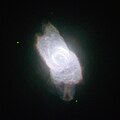Файл:NGC 6572.jpg
NGC_6572.jpg (500 × 500 нокта, файл зурлыгы: 135 Кб, MIME төре: image/jpeg)
Файл тарихы
Файлның нинди булганлыгын күрү өчен «дата/вакыт» дигәненә басыгыз.
| Дата/вакыт | Кече рәсем | Үлчәмнәре | Кулланучы | Искәрмә | |
|---|---|---|---|---|---|
| агымдагы | 14 дек 2010, 17:08 |  | 500 × 500 (135 Кб) | Antonsusi | Better jpg-quality, less environment of no interest |
| 13 дек 2010, 14:59 |  | 629 × 638 (68 Кб) | Jmencisom | {{Information |Description={{en|1=The NASA/ESA Hubble Space Telescope has turned its eagle eye to the planetary nebula NGC 6572, a very bright example of these strange but beautiful objects. Planetary nebulae are created during the late stages of the evol |
Файлны куллану
Әлеге файл киләсе битне куллана:
Файлның гомуми кулланышы
Әлеге файл аста бирелгән викиларда куллана:
- ar.wikipedia.org проектында куллану
- az.wikipedia.org проектында куллану
- be.wikipedia.org проектында куллану
- ce.wikipedia.org проектында куллану
- cs.wikipedia.org проектында куллану
- de.wikipedia.org проектында куллану
- diq.wikipedia.org проектында куллану
- en.wikipedia.org проектында куллану
- fa.wikipedia.org проектында куллану
- fr.wikipedia.org проектында куллану
- hr.wikipedia.org проектында куллану
- it.wikipedia.org проектында куллану
- it.wikibooks.org проектында куллану
- kk.wikipedia.org проектында куллану
- mk.wikipedia.org проектында куллану
- nl.wikipedia.org проектында куллану
- pl.wikipedia.org проектында куллану
- pt.wikipedia.org проектында куллану
- ru.wikipedia.org проектында куллану
- sk.wikipedia.org проектында куллану
- tr.wikipedia.org проектында куллану
- www.wikidata.org проектында куллану
- zh.wikipedia.org проектында куллану

